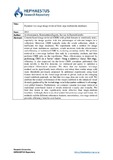| dc.contributor.author | Arampatzis, Avi | |
| dc.contributor.author | Zagoris, Konstantinos | |
| dc.contributor.author | Chatzichristofis, Savvas A. | |
| dc.date.accessioned | 2017-10-30T10:36:38Z | |
| dc.date.available | 2017-10-30T10:36:38Z | |
| dc.date.issued | 2013 | |
| dc.identifier.issn | 0306-4573 | |
| dc.identifier.uri | http://hdl.handle.net/11728/10169 | |
| dc.description.abstract | Content-based image retrieval (CBIR) with global features is notoriously noisy, especially for image queries with low percentages of relevant images in a collection. Moreover, CBIR typically ranks the whole collection, which is inefficient for large databases. We experiment with a method for image retrieval from multimedia databases, which improves both the effectiveness and efficiency of traditional CBIR by exploring secondary media. We perform retrieval in a two-stage fashion: first rank by a secondary medium, and then perform CBIR only on the top-K items. Thus, effectiveness is improved by performing CBIR on a ‘better’ subset. Using a relatively ‘cheap’ first stage, efficiency is also improved via the fewer CBIR operations performed. Our main novelty is that K is dynamic, i.e. estimated per query to optimize a predefined effectiveness measure. We show that our dynamic two-stage method can be significantly more effective and robust than similar setups with static thresholds previously proposed. In additional experiments using local feature derivatives in the visual stage instead of global, such as the emerging visual codebook approach, we find that two-stage does not work very well. We attribute the weaker performance of the visual codebook to the enhanced visual diversity produced by the textual stage which diminishes codebook’s advantage over global features. Furthermore, we compare dynamic two-stage retrieval to traditional score-based fusion of results retrieved visually and textually. We find that fusion is also significantly more effective than single-medium baselines. Although, there is no clear winner between two-stage and fusion, the methods exhibit different robustness features; nevertheless, two-stage retrieval provides efficiency benefits over fusion. | en_UK |
| dc.language.iso | en | en_UK |
| dc.publisher | Elsevier | en_UK |
| dc.relation.ispartofseries | Information Processing and Management;Volume 49 Issue 1 | |
| dc.rights | © 2012 Elsevier Ltd. All rights reserved. | en_UK |
| dc.rights.uri | http://creativecommons.org/licenses/by-nc-nd/4.0/ | en_UK |
| dc.subject | Multimodal retrieval | en_UK |
| dc.subject | Multimedia retrieval | en_UK |
| dc.subject | Image retrieval | en_UK |
| dc.subject | Fusion | en_UK |
| dc.title | Dynamic two-stage image retrieval from large multimedia databases | en_UK |
| dc.type | Article | en_UK |
| dc.doi | https://doi.org/10.1016/j.ipm.2012.03.005 | en_UK |


